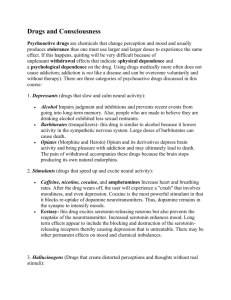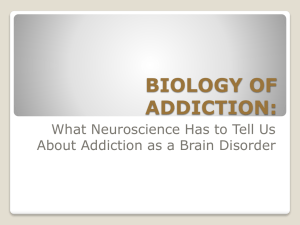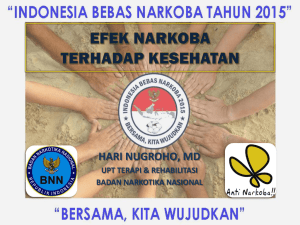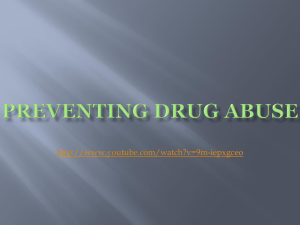Power Point for Katherine van Wormer and Diane Rae Davis
advertisement
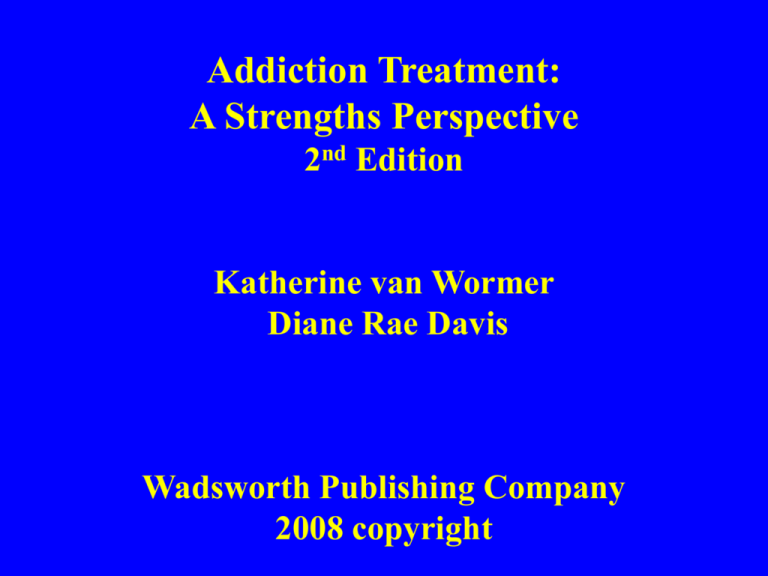
Addiction Treatment: A Strengths Perspective 2nd Edition Katherine van Wormer Diane Rae Davis Wadsworth Publishing Company 2008 copyright Part I: Introduction • Addiction affects us all. Strengths perspective—strengths of clients and strengths of the contemporary models: – harm reduction – 12 Step approach. • Rift in field. • Book in 3 parts: bio-psycho-social Chapter I Nature of Addiction • Examples of addiction---smoker dying of emphysema, crack addict arrested, pregnant mother drinking heavily, girl hooked on meth she started using to lose weight • Economic cost—health, war on drugs, over 1 million in prison for drug involvement. Big business—gambling, Philip Morris, beer What is addiction? • (Latin) addictus---attached to something, positive. Today alcoholism called a “brain disease”or bad habit or sin. Leading assumption of the text: Addiction is the key, not the substance or behavior • Addiction defined by researchers as “a bad habit,” “a brain disease,” “helplessness,” “a problem of motivation” DSM-IV-TR Substance dependence: requires 3 of following: tolerance withdrawal problems use more than intended reduced involvement inability to stop excessive spending or effort to obtain continued use • Rigid dichotomy here between abuse and dependence. Van Wormer and Davis disagree, see addiction as a continuum. People move in and out of addiction. • DSM prefers term dependence over addiction. Definitions Abuse—unlike dependence does not include these criteria: tolerance, withdrawal, pattern of compulsive use. Addiction—pattern of compulsive use. •Has physical, psychological, social aspects. •Emphasis on process rather than outcome. Box 1.1 A Social Work Major Working in a Casino • What is the ethical dilemma here? • How do the managers ensure that the gamblers keep spending their money? • How are the employees controlled by the establishment? The Disease Concept • Is alcoholism a disease? • Arguments by class pro: • Arguments con: First, Define Disease • Disease - as metaphor by Jellinek: “alcoholism is like a disease” • Random House Dictionary, disease is a condition of the body in which this is incorrect function. • Oxford University Dictionary– disease is absence of ease (in treatment – disease as: primary, progressive, chronic, and possibly fatal). • Illness – term preferred here, less controversial, less medical. • Best arguments pro disease: alcoholism is a brain disease because the addicted brain has changed. • Best arguments against: just a habit, a behavior, need to take responsibility, people mature out of it. Biopsychosocial-spiritual Model • Why (bio), what (psycho), where (social) • Need for spiritual healing, connection with Higher Power • Interactionism and cycle of pain: pain and suffering loss pain, stress and drinking more pain • Family as a system in interaction, roles Why Do We Need to Know about Addiction? • 80% of people behind bars have problems, pervasive in child welfare system, alcoholics in the workplace. • 71% of social workers worked with clients with substance abuse disorders in the past year. • Headlines: -“Hooked on Tanning?” -“Shopaholics Climb on the Wagon” • Relevant movies: 28 days, Traffic, Walk the Line Strengths Perspective Charles Rapp: Six critical elements: person is not the illness, choice, hope, purpose, achievement, presence of one key person to help. • Finding the strengths in divergent models, • Newer ones and traditional approaches. • Different models for different folks. • Very negative view of disease model: Stanton Peele: Resisting 12 Step Coercion • Harm reduction and the strengths perspective— “meet the client where the client is.” Policy issues of reducing harm. Empirical Research Project MATCH Directed by NIAAA – 2,000 clients over 8 yrs. What works? 12 step facilitation, cognitive, motivational enhancement therapy (MET) MET most effective for those with low motivation, 12 Step with religious persons. • • Criticism: lack of a control group. MET, a shorter intervention. Models only tested on alcoholic clients. Project MATCH confirms the effectiveness of diverse treatments. New measure for recovery is improvement, not total abstinence. Valliant’s Research 40 year longitudinal study—those who recovered had crisis with alcohol or joined AA or entered a stable relationship or had a religious conversion. Empirical Research Continued • Research from California: 1$ spent saves 7 across states. • Hester and Miller found that these treatment modalities were proven to be most effective: brief intervention, motivational interviewing (MI), medicine naltrexone, social skills training, aversion therapy, cognitive therapy, acupuncture. (See chapter 5) Treatment Trends • Harm reduction recognized important to save lives, • Belief that punitive laws cause harm. • 69% of Americans favor treatment over jail. • Treatment now often provided in prison. • Drug courts. • Attention to co-occurring disorders. • Restorative Justice: Victim-offender programming to promote healing. Chapter 2 Historical Perspectives Early History • Alcohol back to 5000 BC Iran • Unknown to world’s indigenous people • Koran --- condemned wine. Alcohol from Arabic al-kuhul. • Arabian dr. discovered evaporated distilled spirits. Technology exceeded its grasp • 1575 --- distilling used–gin. Booze from Dutch busen. • Great devastation from England, 1700-1750. • Infant mortality, crime North America • More beer than water on Mayflower. • Slaves forbidden to drink except on special occasions, taught bingeing. • Puritan traditions. • 18th – Quakers and Methodists disapproved of hard liquor. • Male drinking cult 1725-1825 notorious. Temperance movement • 1825-1919: Against hard liquor. • Temperance woman for women’s suffrage and ban on distilled beverages. Early 1900s • Cocaine in Coke • 1914 Harrison Act --- restricted opioids (associated with Chinese people) cocaine must now be prescribed. • Marijuana (associated with Mexicans) State laws in southwest criminalized. • Teetotaler T =total abstinence, from Ireland. U.S. Prohibition 1920-1933 • Glamorized crime. Mafia/ Hollywood/Wash. DC link. Homicide rates increased. • Great Depression created need for jobs. Chapter Themes of First Half • Dangers of potent alcohol, role of ethnic prejudice in shaping drug legislation, unintended consequences of prohibition. • Example of happy Italian family enjoying wine with their meals. • Modern War on Drugs, 70% of money for law enforcement. History of Addiction Treatment • William White, Slaying the Dragon. Mistreatment of persons with mentally illness and alcoholics in asylums. Getting Better by Nan Robertson tells of Bill W. and Dr. Bob. Oxford Groups. Big Book. 2 million members in AA worldwide today. • Jellinek (The Disease Concept, 1960) – 5 types of alcoholism based on world travels: • Alpha, Beta, Gamma , Delta, Epsilon. Treatment History continued • 1956 AMA declared alcoholism a disease, 1966, a disease. • Harold Hughes –founded NIAAA. • Hazelden adapted 12 Step approach. • Box 2:1—“Treatment in Norway”— universal health care for support. • Peele and Fingarette: addiction as bad habits not disease. History of Harm Reduction • AIDS in Netherlands spawned new approach, to reduce the harm. • Britain, 1960s and later. • Heroin prescribed. Needle exchanges-U.S. Chapter 3 Strengths Based Helping Strategies Dennis Saleebey • Focus on possibilities, choices—providing treatment options. • Resilience, healing, and wholeness. • Contrast with problem-solving approach. Two Approaches to Treatment Traditional Bio Dichotomy Psycho Problems mandate—one size fits all Social Identify family dysfunction Strengths-based Bio Continuum Psycho Strengths-motivation Social Holistic family as resource Four Models of Strengths-Based Approaches 1. Harm reduction: public health model, prevention, outreach. Abstinence not precondition to treatment Stages of Change Model: Prochaska and DiClemente Precontemplation Contemplation Preparation Action Maintenance Relapse 2. Motivational Interviewing (MI)---William Miller • Asking the right questions; “Tell me about a period when you were doing well?” • Smoking: on a scale of 1-10 to give up smoking, where are you now? • MI Steps to enhance motivation: Express empathy Develop discrepancy Avoid argumentation Roll with resistance Support self-efficacy 3. Solution focused therapy • • • • Miracle question The personal narrative Scaling questions Coping questions 4. Narrative Therapy • Therapist works to uncover evidence of past competence • Help in rewriting a “new life story” • Group work to discourage stories of problems and failures Traditional Treatment: • Detox—opportunity to introduce patient to choices • Outpatient—primarily group counseling • Inpatient and halfway houses • Aftercare once a month, may be 12 Step group or religious activity Part II BIOLOGY Chapter 4 Substance Misuse, Dependence, and the Body Recent Trends PET scans, fMRI functional magnetic resonance imaging Craving research New facts on brain damage Depressants Alcohol Figure 4.1—alcohol involvement: 39% of those in prison for violence; 39% of traffic fatalities;67% in domestic violence, 40% in rape; 72% date rape; 50% child abuse and neglect; 23% of suicide. Father Martin- -Chalk Talks: Jocose drunk, amorose, bellicose, lachrymose drunks Others: somnos drunk, (sleepy) clamorose, (loud), scientose (know it all) Alcohol continued • Health effects—heart • 7-10% of drinkers get addicted. Signs: tolerance, withdrawal (tremors, nausea), heavy nicotine, caffeine use • Tolerance reversal • .4 B.A.C. may be comatose. • Blackouts: common at .3 BAC, case in Tom Sawyer • Real court cases Drinking Rates in Liters of Alcohol • Iran— 0.0 • India—.82 • Cube—3.65 • Mexico—4.62 • Norway—5.81 • Japan—7.38 • U.S.—8.51 Some have high consumption with few problems. • • • • • • Italy—9.14 Greece—9.30 UK—10.39 Denmark—11.93 France—13.54 Ireland—14.45 Narcotics • Opiates—from opium poppy…narcotics, heroin now can be smoked or snorted • Inhalants—household products, huffing, brain damage, coma • Misuse of pain medication increasing today • OxyContin Stimulants • Cocaine-crack and powder, in urine 8 hrs., smoked for faster high. • Brain blocks reuptake of dopamine… Addicted rats die… heart attack. • Amphetamines and meth—synthetic unlike cocaine— suppresses appetite. • Powder can be snorted, injected. Stay awake for long durations… • Anhedonia---inability to feel pleasure with druginduced brain injury. Nicotine • Can both stimulate and relax. 80-95% of alcoholics smoke, reduces alcohol effects. Over ½ of schizophrenics smoke. • Nicotine decreases BAC levels. • Malachy McCourt smoked for ad and got hooked. • Box 4.1 “To Die for a Cigarette” • Case of chewing tobacco—snuff Hallucinogens • Plants, LSD, synthetic, flashbacks, PCP • Ecstasy and roofies—heightens sensory experience…raves.. • Can’t get back to original high due to brain changes. • 10% in high school have used Ecstasy. • Dance Safe – harm reduction strategies. • Roofies:--sleeping pill in Europe. What Is Ecstasy? Split Ecstasy is a drug that has some hallucinogenic properties and is structurally related to amphetamines. Its short form chemical name is MDMA (3,4methylenedioxymethamphetamine). Short Term Effects of Ecstasy • • • • • • • Feeling of confidence Sense of arousal Increased heart rate Dry and sore mouth/throat Tension, High Body Temperature Muscle twitching Depression & Confusion Long Term Effects of Ecstasy • • • • • • • Liver damage Anxiety disorders Irregular heartbeats Brain damage Depression Confusion Paranoia Cannabis • Marijuana • THC, the psychoactive ingredient, lowers blood glucose, increases appetite, Stored in fat cells, long term use possibly associated with apathy. • Earlier reports of lung cancer after longterm use were not validated. Costs to Get High Estimates Differ by Region • Crack: $5-10 quick fix only lasts 30 min. • Heroin: $100-200 day--$20 day can by maintenance dose inject a couple of times • Ecstasy: $10-20 may take 5 or so pills. • Meth: $25 long-lasting high, popular in gay party scene in Seattle, factory workers in Iowa • Marijuana: $25 or higher, depends on quality Metabolism • Liver: organ that metabolizes alcohol, alcohol circulates in the bloodstream until metabolized. • Men have special enzymes help. People metabolize ½ oz. Per hour = small glass of wine….1 BAC=1/1000 parts blood. • Acetaldehyde and Antabuse • Flushing in Asians • Multiplying effect of 2 sedatives. • Tylenol plus Alcohol >liver failure. • Valium is used to bring one down from cocaine (ex. Robert Downey). Brain Regions and Their Functions The Brain and Addiction Neurotransmitters affect emotions and memory Neurotransmitters Affect Emotions and Memory • Dopamine—reuptake affected by cocaine, which blocks dopamine synapse • Depletion following cocaine use. Nicotine affects dopamine too. • Parkinson’s when too little. Dopamine-boosting drugs for Parkinson’s associated with mania and gambling behavior. • Too much dopamine associated with schizophrenia • Serotonin: influenced by alcohol, involved in sleep. Decreased levels linked to depression, anxiety, impulsiveness suicide. Depletion following cocaine use. Nicotine affects dopamine too. The right scan is taken from someone who is on cocaine. The loss of red areas in the right scan compared to the left (normal) scan indicates that the brain is using less glucose and therefore is less active. This reduction in activity results in disruption of many brain functions. Memory and Craving • Addict never gets original high—brain has changed. Addiction is a brain disease. • Cues can trigger memory…picture of alcoholic beverages activates certain areas of the brain. • Prozac reduces craving by regulating serotonin levels. Cocaine in the Brain Slides are from the National Institute on Drug Abuse (NIDA) (www.nida.nih.gov) The Role of Genes • Study of mental hospitals, prisons, 50% who used chemical substances had mental disorders. • Cloninger—Sweden..259 male adoptees with alcoholic fathers • Type 1: late onset..75% of alcoholics, relates to harm avoidance, anxiety, guilt • Type 2: risk taker, (starts about age 11) male, hyperactive, antisocial, hereditary • Ondansetron: works on Serotonin, little effect on type 1 • Twins: 40-60% concurrence of alcoholism. Separated at birth monkeys drank more under stress, people with low dopamine like stimulants • People with ADHD risk for drug abuse. Medical Consequences • • • • • Wernicke Korsakoff: Cases reported of Dr. Oliver Sachs Peripheral neuropathy related to lack of Vitamin B Confabulation….Dr. Sachs—Awakenings Liver damage…removes toxins from blood, bile circulates in blood stream • Yellow skin tone, cirrhosis, immune system breakdown. • Heart – nicotine, cocaine • Fetal alcohol syndrome. See photographs in text. Chapter 5 Interventions Related to Biology Schick Shadel • Seattle treatment center • Conditioning or aversion therapy • Interview with administrator explains use of truth serum, etc. Changing Brain Chemistry • Brain Lock (Schwartz) cognitive treatment for OCD to “rewire the brain” • Ondansetron—decreases craving • Zyban and smoking; Chantix helps person produce more dopamine. • Nicotine gum; patch. • Naltrexone, approved 1995, not a narcotic unlike methadone. • Blocks receptors for getting high. Synthetic Prescription Drugs • • • • Methadone (synthetic form of heroin); Methadone maintenance Heroin maintenance in Britain, Switzerland. Buprenorphine can be prescribed by GP’s, reduces likelihood of overdose • • • • Eating disorders and dopamine Bulimics—related to depression Anorexia—anxiety Luvox decreases binges. Holistic Treatments • • • • • • Herbal remedies St. John’s wort Hypnosis Acupuncture from China Massage therapy Physical exercise to reduce tension Assessment • Need for assessment forms to be sensitive to gender/cultural differences • Language differences, e.g., the word craving hard to translate • CAGE and TWEAK work well with women CAGE • • • • Have you tried Cutting down? Have people Annoyed you? Have you felt Guilty about your ATOD use? Have you ever used ATOD as an Eye opener? TWEAK • • • • • Tolerance Worried Eye Openers Amnesia Kut down Works well with mixed ethnic populations Other Screening Forms • AUDIT developed by WHO for alcohol use • NIAAA—50 item instrument, Inventory of Drug Use Consequences, in public domain • WHO designated areas of harm caused by drink—physical, emotional, health, family, finances, etc. UAs • Raises ethical questions • Inconsistent with harm reduction, MI, strengths-based models, according to the text • Sweat patch a less invasive form of testing Strengths-Based Assessment • Focus not on pattern of use, negatives • Emphasis on client choice, soliciting positive information • Note periods of using less, times of abstinence, family rituals. • “What has endured in your life despite substance use?” Work with Homeless • Housing First programs, harm reduction, for persons with co-occurring disorders • “Sober housing” no more effective in preventing harmful drug use • Motivational strategies helpful Group Work • • • • Early stage: when physiological stress Develop group norms; sets rules, Intervene when: - all-or-nothing thinking -one person monopolizes group -it turns into a gripe session Exercises to help people find strengths: -Cards: I feel happy when, scared when, etc. -3 minute feeling level exercises End of Chapter 5 and Part II
